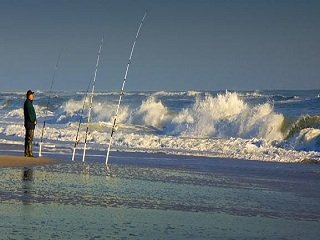 There aren’t many who would turn down the chance to stand on a sandy beach while the surf crashes over their toes as they enjoy the warm breeze of the ocean. How can it get any better? Well, if you combine that with fishing, then you, my friend, have a one-upper on your hands. This is what’s known as surf fishing and it’s well-known as a relaxing, social way to catch huge fish while enjoying the beach in your own way. Anyone out there can take part in such an enjoyable activity and all it takes is some heavy-duty tackle, live bait, and attention to subtle changes in the nearby waters.
There aren’t many who would turn down the chance to stand on a sandy beach while the surf crashes over their toes as they enjoy the warm breeze of the ocean. How can it get any better? Well, if you combine that with fishing, then you, my friend, have a one-upper on your hands. This is what’s known as surf fishing and it’s well-known as a relaxing, social way to catch huge fish while enjoying the beach in your own way. Anyone out there can take part in such an enjoyable activity and all it takes is some heavy-duty tackle, live bait, and attention to subtle changes in the nearby waters.
The key to effective surf fishing is learning to read the surf in order to gauge where the action is. This involves precision timing, seeking out an optimal location, and reading the activities of other animals in the area. While you never want to intrude upon someone else’s spot, look for groups of locals when you head out to the beach to fish. Often, these die-hards will know exactly what to look for and where to look for it. Without setting up shop right on top of them, ask for any advice from them and pay attention to detail. Finding a good spot on your own, however, doesn’t have to hard either. Simply look for rip currents, where breaks in the sand bars will pull baitfish outward. This is where you’ll want to cast your own bait.
Equipping yourself with the right tackle is the key to surf fishing. You won’t be able to simply grab your bass setup and head out to the beach. Be sure to pick up a rod ranging from 12 to 15 feet with large guides and a long, long handle. You’ll also need heavier line—20 to 25 pound test should do it—in order to keep the bait from snapping your line and also to muscle in large fish. You’ll notice that surf rods possess longer handles. This is because they’re designed to rest in sand spikes, which are usually PVC pipes that are lanced into the sand securely. You’ll also need heavier sinkers than what you may be used to. Six-ounce pyramid sinkers or spider weights are perfect, as they’re designed to keep your bait in place by digging into the sand. Lastly, pick up some circle or Kahle hooks so that the fish hook themselves and you can reach for the rod without rushing.
Bait will vary depending on the location, but mullet, shrimp, squid, sand fleas, or cut bait are all great options that appeal to most species. Be sure to keep them securely confined to a cooler though, as open bait will attract flies and birds. If artificial lures are more to your liking, I suggest keeping an assortment of spoons, topwater plugs (when the water’s calmer), and any plastics that imitate natural prey items.
There’s nothing quite like relaxing on the beach with friends, and surf fishing takes such a leisurely, enjoyable day and makes it that much better. Simply heave your bait out as far as you can get it, rest the rod in a sand spike, sit back, and wait for the rod to bend. It’s hard to believe that something so easy and so simple can be so fun, but I promise that once you try it, you’ll be hooked.








